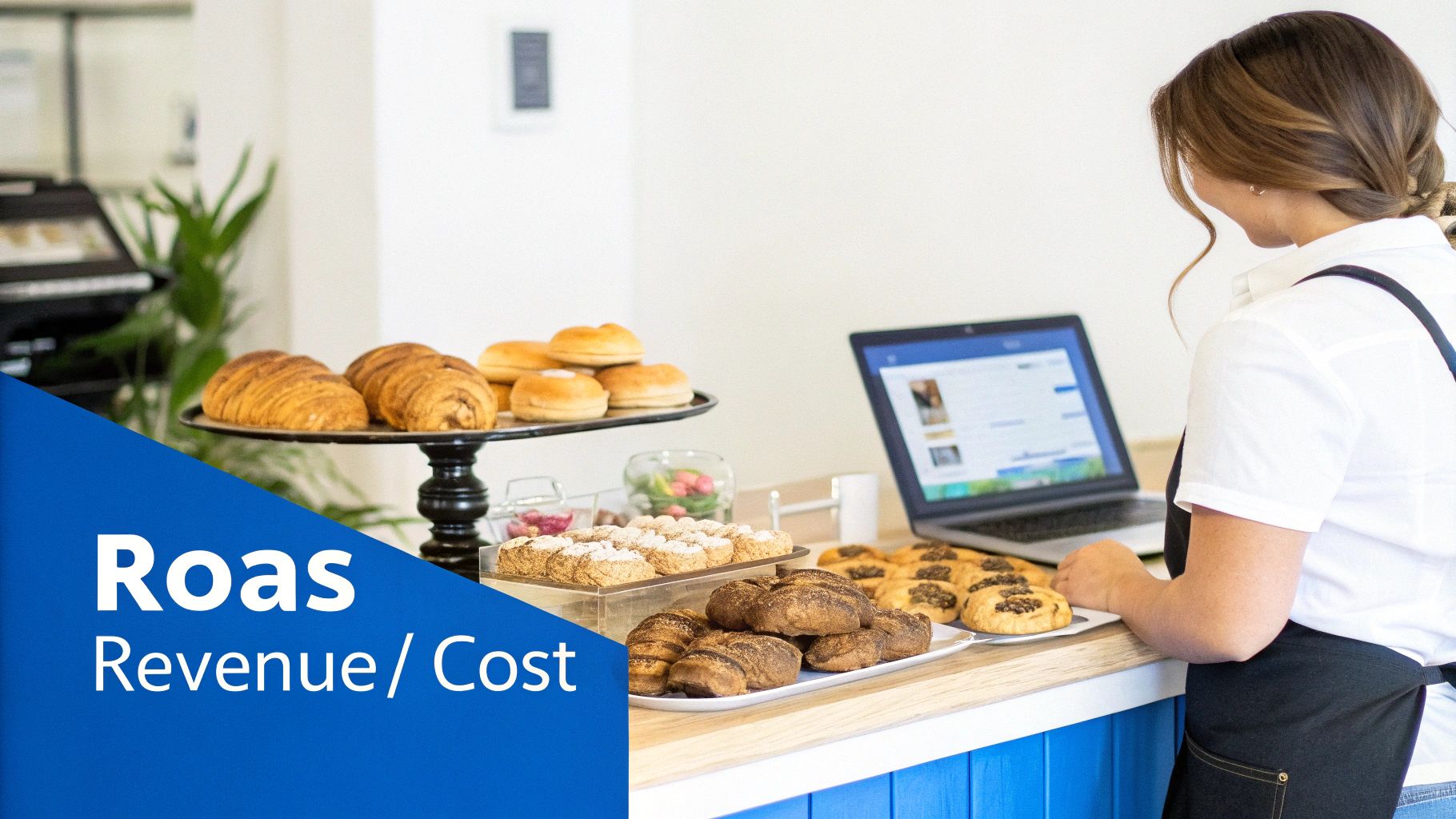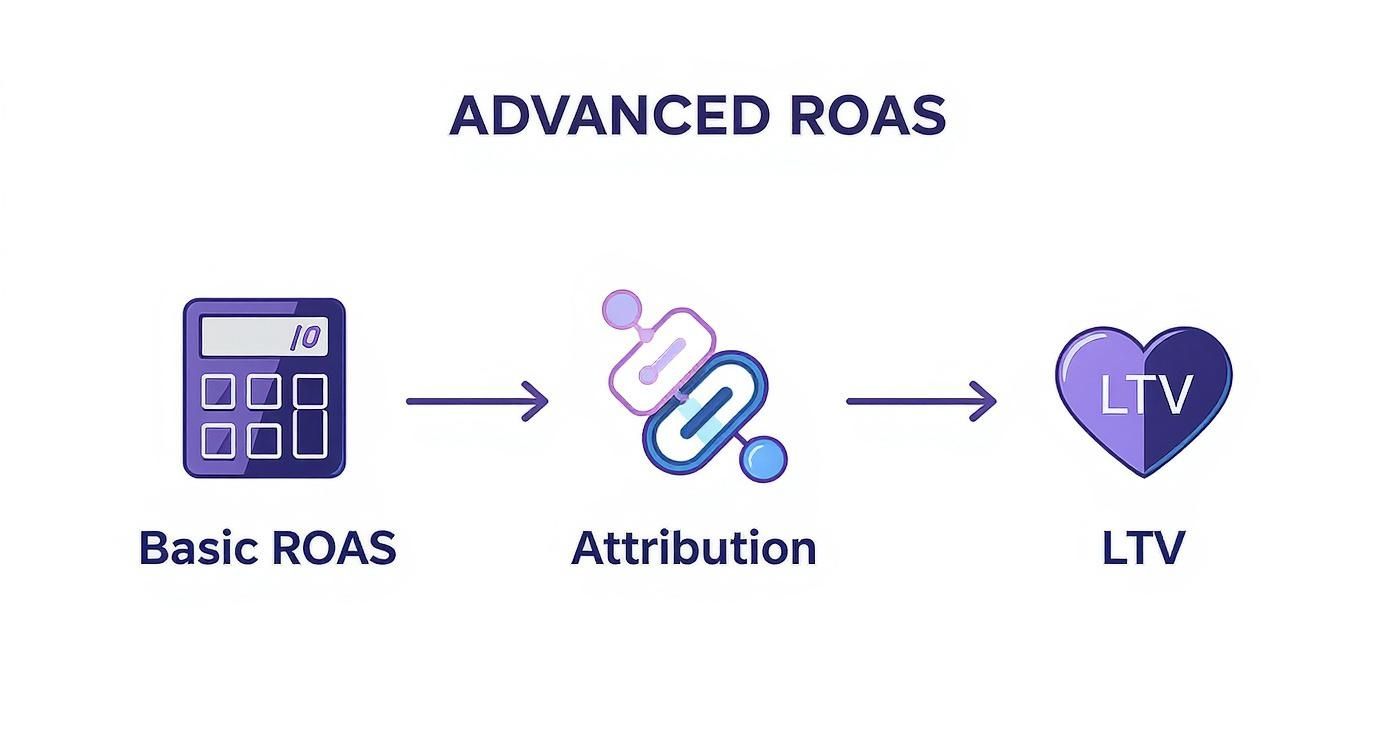At its core, the return on ad spend formula is simple: Total Revenue from Ads ÷ Total Ad Cost. This little equation tells you exactly how much money you get back for every dollar you put into an ad campaign. It’s a direct, no-fluff snapshot of your marketing profitability.

Think of your ad budget as the fuel you pour into your business's growth engine. The ROAS formula is the gauge that shows how efficiently that engine is burning fuel. It cuts right past vanity metrics like clicks or impressions and hones in on what really matters: revenue. A high ROAS means your ads are hitting the mark and turning viewers into paying customers.
Let's make this real with a quick analogy. Imagine a local bakery spends $200 on social media ads for a new line of cupcakes. Over the weekend, they track their sales and find that customers who saw the ad spent a total of $1,000.
Using the formula, we get:
This gives them a ROAS of 5, which is often shown as a 5:1 ratio. For every single dollar they invested in advertising, they got five dollars back in sales. It’s a powerful, straightforward health check on their marketing investment.
The simplicity of the formula can be a bit deceiving. To get a number you can actually trust, you have to be super precise about what goes into each side of the equation.
Here's a quick breakdown to help you get your numbers straight:
Getting these inputs right is the first step toward making reliable, data-driven decisions with your ad spend. While ROAS is a fantastic measure of ad effectiveness, it's important not to confuse it with broader business metrics. If you want to go deeper, check out the key differences between ROI vs ROAS in our guide.

Alright, now that you know what goes into the return on ad spend formula, let's get our hands dirty and actually use it. This isn’t about advanced math; it’s about being a good bookkeeper and making sure you’re counting everything correctly.
To show you how it works, we’ll follow a fictional e-commerce store, "Crafty Mugs," as they crunch the numbers on their latest holiday campaign. The whole thing breaks down into three simple steps: add up your costs, find the revenue, and do the division. Get this right, and your ROAS will be a reliable map for your marketing, not just a shot in the dark.
First things first, you need to add up every single dollar that went into the campaign. It's tempting to just look at the invoice from your ad platform, but that rarely tells the whole story. To get a true sense of your investment, you have to dig a little deeper.
For Crafty Mugs, their total cost is more than just the $2,000 they paid to run the ads. Let's look at their full spend:
When you add it all up ($2,000 + $350 + $50), you find Crafty Mugs' true Total Ad Cost is $2,400. Accounting for these "hidden" costs is the key to an honest ROAS calculation. Otherwise, you're just inflating your own numbers.
Next up, you have to figure out exactly how much revenue the campaign brought in. This is where good tracking becomes non-negotiable.
Using their analytics platform, Crafty Mugs can see that clicks from their holiday ads led directly to $9,600 in total sales. This is their Total Revenue from Ads.
It’s crucial to use an attribution tool that can accurately connect a sale back to a specific ad. If your tracking is sloppy, you might accidentally give your ad campaign credit for revenue that actually came from organic search or an email newsletter. That will completely throw off your numbers. For a closer look at the mechanics, check out this expert guide on calculating Return On Ad Spend.
You’ve got the two key numbers. Now for the easy part. Just plug them into the formula:
ROAS = Total Revenue from Ads ÷ Total Ad Cost
For our friends at Crafty Mugs, the math is simple:
$9,600 (Revenue) ÷ $2,400 (Cost) = 4
Their ROAS is 4. You’ll often see this written as a 4:1 ratio. This means for every $1 Crafty Mugs invested in their holiday campaign, they generated $4 in revenue. That’s a clear, powerful metric they can use to judge the campaign's success and plan their budget for next year.
And if you want to skip the manual math, a good Return On Ad Spend calculator can run the numbers for you in seconds.
So you've run the numbers, and you're staring at your ROAS. It might be a 3:1, a 5:1, or maybe even something in the double digits. But what does that number actually mean for your business? The question every marketer asks is, "Is this a good ROAS?"
The honest, and only, answer is: it depends.
There's no universal magic number that guarantees success. A "good" ROAS is completely tied to your business model, profit margins, and industry. For a company selling high-margin software, a 3:1 ROAS could be fantastic. But for an eCommerce store with razor-thin margins, that same 3:1 could be a fast track to going broke.
Your goal isn't to hit some generic industry benchmark. It's to find the ROAS that makes your business profitable and lets you scale sustainably. Think of it as your company's unique financial fingerprint—what works for someone else probably won't work for you.
Before you can even think about setting a target ROAS, you have to know your break-even point. This is the absolute minimum ROAS you need to cover your costs. Anything below this number means you're losing money on your ads. Anything above it is profit.
Calculating this means looking past your ad spend and factoring in your Cost of Goods Sold (COGS).
Let's say you sell a product for $100. If your COGS is $60, your profit margin is 40%. To break even, your ad campaigns need to generate enough revenue to cover not just the ad cost, but the cost of the product, too.
While your break-even ROAS is personal, it helps to know what’s happening in the world around you. Industry averages give you context, helping you understand the competitive landscape and set goals that are ambitious but still grounded in reality. For example, in eCommerce, ROAS is one of the most vital metrics for fueling growth.
The screenshot below gives you a glimpse into some common industry benchmarks.
This data shows that while a 4:1 ROAS is a common goal, the reality is often quite different. Many successful eCommerce stores aim to beat the average industry benchmark of 2.87:1, but they have to constantly balance what they spend to acquire a customer with the revenue that customer brings in. For a deeper dive, you can discover more insights about eCommerce ROAS on opensend.com.
Ultimately, ROAS is just one piece of the puzzle. To get a complete picture of your campaign health, you need to track it alongside other important marketing dashboard KPIs. This is how you make sure you’re making smart decisions based on the whole story, not just one chapter.
On the surface, calculating your return on ad spend seems simple enough. But tiny errors can have a massive impact, leading to flawed strategies and a whole lot of wasted budget. An inaccurate ROAS is often worse than having no metric at all.
Getting this number right means sidestepping a few common—but critical—mistakes.
One of the most frequent errors we see is forgetting all the "hidden" costs that go into an ad campaign. It’s tempting to just plug in the final number from your Google Ads or Meta invoice, but that rarely captures the full picture of your investment.
True ad cost includes everything it took to get that campaign live and running.
To get an accurate number, you have to account for:
Forgetting these costs will artificially inflate your ROAS, making a campaign look far more successful than it really is. It’s like calculating the profit on a cake but forgetting to factor in the cost of the oven you used to bake it.
Another major pitfall is getting your revenue attribution wrong. If you can't confidently tie a sale back to a specific ad, your entire calculation is built on shaky ground. This usually happens when tracking isn't set up correctly, causing you to give credit to the wrong touchpoint for a conversion.
This is a huge issue for marketers. Fixing it often requires a more robust tracking setup to see the complete customer journey. You can learn more about navigating these issues in our guide on common attribution challenges in marketing. Without clear attribution, you could end up scaling an ad that isn’t actually driving results.
Finally, a classic mistake is confusing ROAS with its strategic cousin, Return on Investment (ROI). They sound similar, but they measure very different things and answer different questions about your business's health.
ROAS measures the gross revenue generated for every dollar you spend on ads. It's purely focused on the effectiveness of your advertising. ROI, on the other hand, calculates the overall profitability of an investment after all costs—including your cost of goods sold (COGS) and overhead—are subtracted.
Understanding this distinction is crucial. A campaign can have a fantastic 4:1 ROAS but still result in a negative ROI if your product margins are too thin to cover all your other business expenses.
To help clear this up, let's break down the key differences.
While both metrics are vital for measuring performance, they serve distinct purposes. ROAS gives you a tactical view of your ad campaigns, while ROI provides a strategic look at overall business profitability.
Using these two metrics together gives you a much more complete picture. ROAS tells you how well your ads are working, and ROI tells you if the business is actually making money from them.

Knowing your ROAS is just the starting line. The real growth happens when you start actively pushing that number higher. And boosting your return isn't just about spending more money—it’s about spending smarter.
It’s about making data-backed tweaks that turn every dollar you spend into a more powerful engine for revenue. The goal is to refine your entire approach, from who you’re targeting to the experience they have after the click.
The fastest way to torch your ad budget is to show your ads to the wrong people. Simple as that. Pinpointing your ideal customer profile eliminates wasted spend and makes sure your message actually lands with someone who might care.
Don't be afraid to get granular. Modern ad platforms give you incredibly powerful tools to zero in on exactly who you want to reach.
When you narrow your focus, you concentrate your ad spend where it will have the most impact. That's a direct path to a better return.
Once you've found the right audience, you have to grab their attention. Generic, boring ads get scrolled past in a heartbeat. Creative that speaks directly to a user's pain points and desires is what drives action.
This is where relentless testing becomes your best friend.
A/B testing isn't just a "best practice"—it's a requirement for growth. Systematically testing different headlines, images, and calls-to-action can uncover some wild insights. Sometimes a tiny change, like swapping a button color or rephrasing a headline, can lead to a 20% or 30% jump in conversions.
Never assume you know what will perform best. Let the data tell you what your audience actually responds to. For more ideas on what to test, check out these 30 tips to improve ad performance and see what sparks some inspiration for your own campaigns.
Your ad is only half the battle. Think about it: you can have the most compelling ad in the world, but if it sends someone to a slow, confusing, or totally irrelevant page, you’ve just wasted that click. The journey from ad to conversion needs to be seamless.
Your landing page must deliver on the promise your ad made. If your ad promotes a specific discount on a specific product, that product and discount better be front and center on the landing page. Any friction, any disconnect, and you risk losing the sale for good.
Mastering the basic return on ad spend formula is a great starting point. It gives you a powerful, at-a-glance snapshot of how a campaign is doing. But a single campaign's ROAS is just one chapter in a much bigger story about your marketing's impact.
To make genuinely strategic decisions, you need to look past the immediate revenue and start thinking about the long-term value your ads are creating. A campaign might have a modest ROAS today, but if it brings in customers who stick around and buy again for years, its true worth is far greater than that initial calculation shows. This is where we need to bring in some more advanced concepts to get the full picture.
One of the most important metrics you can track is Customer Lifetime Value (LTV). Simply put, LTV is the total amount of money you can expect to earn from a single customer over the entire time they do business with you. When you compare your ad cost to a customer's LTV instead of just their first purchase, you get a much clearer, more honest view of long-term profitability.
Think about it this way: a $100 ad spend that brings in a customer who makes one $150 purchase gives you a 1.5:1 ROAS. Not bad, but not amazing.
But what if that same customer goes on to spend another $900 over the next two years? Suddenly, the real return on that initial $100 investment is a massive 9:1.
Considering LTV completely transforms your perspective. It gives you the confidence to invest in campaigns that might have a lower immediate ROAS but are proven to attract high-value, loyal customers who will drive your business forward for years to come.
Another critical piece of the puzzle is your attribution model. This is just the set of rules you use to decide how to give credit for a sale to the various ads and touchpoints a customer interacted with along the way. The model you choose can dramatically change the ROAS you see for different channels.
There are a few common models:
Your choice here really matters. A last-touch model might make your top-of-funnel channels, like social media ads that first introduced your brand, look worthless. On the other hand, a first-touch model might totally ignore the vital role that retargeting ad played in finally closing the sale.
For anyone serious about moving beyond the basic ROAS formula, using comprehensive search engine marketing intelligence is key to understanding how all these channels really work together to drive growth.
As you start weaving the return on ad spend formula into your daily workflow, you're bound to run into a few questions. Let's tackle some of the most common ones that come up for marketers.
One of the first things people ask is how often they should be checking in on their ROAS. For live campaigns, I’ve found that a weekly check-in is the sweet spot. It gives you enough data to see real trends without letting a poorly performing campaign bleed your budget dry. For bigger-picture strategy, a monthly or quarterly review works great.
Absolutely, though you’ll usually see it expressed as a ratio below 1:1. For example, if you spend $1,000 on a campaign but only bring in $700 in revenue, your ROAS is 0.7:1.
That means you’re losing $0.30 for every single dollar you put in. It's a flashing red light telling you to either fix that campaign immediately or shut it down.
Understanding your ROAS isn't just about celebrating wins; it's about quickly identifying financial leaks. A ROAS below your break-even point is a direct indicator of an unprofitable campaign that is actively losing the business money.
Getting a handle on the basic ROAS formula is just the first step. As the visual below shows, it's the foundation for more advanced analysis, leading you toward true attribution and a deep understanding of customer lifetime value.

Think of it this way: if your ROAS numbers aren't solid, none of the deeper marketing insights you're chasing will be either.
Trying to track all the moving parts of your campaigns in a spreadsheet is a recipe for headaches and mistakes. Luckily, there are some great tools out there to automate the process and give you much clearer insights.
Using the right tools gives you the confidence that the numbers you're looking at are actually reliable.
Ready to get crystal-clear attribution and see your true ROAS? Cometly connects every ad to its actual revenue, giving you the power to scale what works and cut what doesn't. Stop guessing and start growing at https://www.cometly.com.
Learn how Cometly can help you pinpoint channels driving revenue.
.svg)
Network with the top performance marketers in the industry